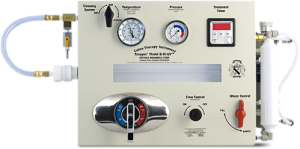 Colonic irrigation (colon hydrotherapy) is an alternative healthcare procedure during which the contents of the colon are washed out using water. Typically carried out in a healthcare spa setting, a machine is used to repeatedly fill the colon with low pressure water and then release it in order to loosen and expel impacted feces and old mucous. The procedure can provide temporary relief from chronic constipation and allows trapped gas to be expelled.
Colonic irrigation (colon hydrotherapy) is an alternative healthcare procedure during which the contents of the colon are washed out using water. Typically carried out in a healthcare spa setting, a machine is used to repeatedly fill the colon with low pressure water and then release it in order to loosen and expel impacted feces and old mucous. The procedure can provide temporary relief from chronic constipation and allows trapped gas to be expelled.
A common statement that is made about colonic irrigation is that it removes “toxins” that build up in the colon. Proponents believe that old feces build up and harbor pathogens or dysbiotic bacteria leading to non-specific ill health. However conventional medicine practitioners deny that such toxins exist and instead point out that frequent irrigation with water can strip protective mucous from the gut wall, and that the procedure holds risk of gut damage and may lead to electrolyte imbalances which can affect the heart.
It is certain that colon hydrotherapy provides a considerable amount of subjective relief from constipation symptoms. It is also true that normal gut flora includes pathogenic species which excrete many forms of bacterial toxins which are potentially pro-inflammatory and irritating to the gut. But the human body has also evolved to live in concert with a wide variety of bacteria and this situation should not be a problem in healthy individuals with intact gut barrier function. Then again healthy individuals typically do not seek out colonic treatments. [Note: I intend to write an nuanced review of the autointoxication hypothesis.]
It is not clear that colonics provide more than a brief respite from gastrointestinal discomfort. Certainly they should not be carried out too frequently. Colonics do have a place as a preparation for fecal transplant therapy where it is desirable to clear out the gut before attempting to implant new bacteria.
In general, when performed responsibly, the colonic procedure is unlikely to result in any injury or health problem. Typically the water pressure used is very low and the filling of the gut is quite gentle. Pressure gauges are used to monitor the progress and the patient is encouraged to report if there is any discomfort.
The experience of a colonic goes like this:
The room consists of a table with disposable coverings and blankets, set up like a massage table. The practitioner leaves the room while you remove your clothes from the waist down and lie on the table under the blanket. When the practitioner returns they will lubricate a short plug shaped tube that they will then insert in your rectum while you are lying on your side. This device is shaped so that it naturally holds into place. A flexible tube is attached which provides water and returns material to the colonic machine which is mounted on a wall. After this you lie on your back with your knees up.
The therapist turns on the water supply and adjusts the temperature. The system constantly sends fresh water to your colon and returns any material through the machine so that it passes through a clear glass window so that whatever comes out can be easily seen. Initially no discernible pressure is present, just a slight washing effect. Eventually the therapist will adjust the machine to start a “fill” and watch the water pressure. Water starts to enter your anus and moves around to fill your whole colon. The pressure will build up and you are expected to let the therapist know when to switch the machine back to the emptying mode. At any rate, pressure gauges indicate how full your colon has become.
Initially, when there are a lot of feces in the gut, not much pressure can be tolerated before it is necessary to switch back to emptying. Material starts to move out of your colon which begins to respond with peristaltic motions which are often quite intense. It can be quite disconcerting for the first time. Eventually, as the fills are repeated, your gut empties out and more “releases” happen with old chunks of material, brown liquid, mucous, and gas bubbles moving visibly along the glass window of the machine.
Sometimes the practitioner will suggest adding substances to the water. Typically these can include chlorophyl, electrolytes, or probiotics. The health benefit of these additives is debatable.
During the procedure, the therapist may spend some time massaging your belly. They will attempt to manually loosen impacted feces by palpating areas of the colon. This is actually surprisingly effective.
A typical procedure will last about one hour. After the procedure the therapist will allow you colon to drain and then disconnect the hoses. Once you are lying on your side again, the therapist will remove the insert. After this they will leave the room allowing you to visit the toilet which is typically situated in the same room.
